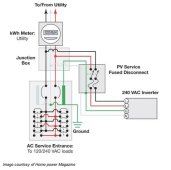Any help is appreciated, let me know if more information is needed.
I want to install a residential 10kw grid tied system using a single SolarEdge SE11400H-US with no batteries. I have a main service panel w/ meter rated at 200 amps and 100 amp sub-panel inside the garage. My understanding is that the 120% rule will allow me 240 amps, then subtract the panel capacity 200 amps for a total of max 40 amps for solar.
How can install a 10kw system with a 200 amp panel without de-rating the panel?
The inverter’s maximum output at 208v is 48.5 amps per the spec sheet. This seems right for any 10kw system: 10,000kw / 208 v = 48.08 amps. The breaker needs to be oversized so: 1.25 x 48.5 = 60.625 => 65 amp breaker. If I were to de-rate the main breaker to 175A this would allow me 65A for Solar PV. Is this the only way to get a 10kw system with a 200A panel?
If I have to de-rate the panel, my current loads are listed below, can I get away with de-rating to 175A? I’m assuming a line side tap is not an option although I haven’t checked with my local building department or utility.
It seems 200A is the standard larger size panel for residential, I see that there are PV ready 225A panels. Is this the only way to get a 10kw systems?
Main Service Panel: GE P-0210, 200 amp max, 40 poles max, branch breakers 90 amp max using CU cable.
Main Service Panel Loads:
100A - House sub-panel
30A - AC
30A - exterior circuit (old hot tub circuit repurposed for powering landscape lights and sprinkler controller this could go away if needed)
60A - Spa (wired sized for 60A, but spa actually only needs 50A)
I want to install a residential 10kw grid tied system using a single SolarEdge SE11400H-US with no batteries. I have a main service panel w/ meter rated at 200 amps and 100 amp sub-panel inside the garage. My understanding is that the 120% rule will allow me 240 amps, then subtract the panel capacity 200 amps for a total of max 40 amps for solar.
How can install a 10kw system with a 200 amp panel without de-rating the panel?
The inverter’s maximum output at 208v is 48.5 amps per the spec sheet. This seems right for any 10kw system: 10,000kw / 208 v = 48.08 amps. The breaker needs to be oversized so: 1.25 x 48.5 = 60.625 => 65 amp breaker. If I were to de-rate the main breaker to 175A this would allow me 65A for Solar PV. Is this the only way to get a 10kw system with a 200A panel?
If I have to de-rate the panel, my current loads are listed below, can I get away with de-rating to 175A? I’m assuming a line side tap is not an option although I haven’t checked with my local building department or utility.
It seems 200A is the standard larger size panel for residential, I see that there are PV ready 225A panels. Is this the only way to get a 10kw systems?
Main Service Panel: GE P-0210, 200 amp max, 40 poles max, branch breakers 90 amp max using CU cable.
Main Service Panel Loads:
100A - House sub-panel
30A - AC
30A - exterior circuit (old hot tub circuit repurposed for powering landscape lights and sprinkler controller this could go away if needed)
60A - Spa (wired sized for 60A, but spa actually only needs 50A)



